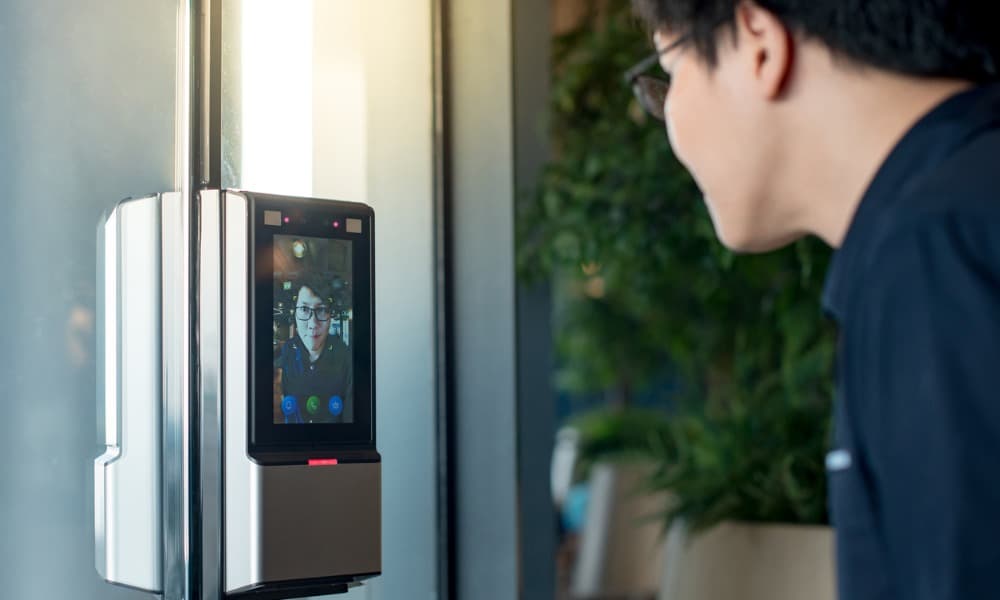Here’s what you need to know about biometric security systems and privacy.
Key takeaways:- As biometric security systems become more prevalent, organizations must implementing them to maximize security without infringing on individual privacy rights.
- The main privacy concerns regarding the use of these systems include potential misuse of data, data breaches, and the risk of surveillance.
- Businesses can balance security and privacy by limiting data collection, obtaining informed consent from users, ensuring safe storage, and establishing clear usage policies.
Understanding biometric security systems
Biometric security systems measure and analyze human characteristics and features to accurately answer two questions about people:- Who are they? (identification)
- Are they who they say they are? (authentication)
- A reader or sensor scans and records the biometric factor being used for identification.
- A program converts scanned or recorded data into digital formats and compares new and saved data.
- A database stores biometric data to facilitate comparison checks.
- Fingerprint recognition, which captures minutiae points like bifurcations, ridge endings, and other unique characteristics of a person’s fingerprint, creating a mathematical template for each pattern for future comparison. Whenever someone must verify their identity, the scanning device compares their fingerprint pattern to the stored template using advanced matching algorithms, granting access with a sufficiently high degree of similarity between the two sets.
- Facial recognition analyzes facial characteristics, such as the positioning, structure, and shape of the jawline, mouth, nose, and eyes to create a digital profile for identification and authentication.
- Iris recognition examines the arrangement of freckles, furrows, and other iris features to verify users are who they claim to be before granting access.
- Voice recognition analyzes vocal features like rhythm, tone, pitch, and speech patterns to authenticate user identity. The user creates a digital voiceprint by recording themselves reciting phrases or text, then the system compares their voice to the stored sample and grants access if it matches. Some voice-recognition technologies recognize voiceprints even through nonfixed phrases, while others require a fixed passphrase.
The security advantages of biometrics
As threats increase and become more sophisticated, businesses must use robust security methods that surpass traditional password protection. Implementing biometric security systems is essential. Biometrics are extremely hard to hack. The variations are so subtle and unique that they require distinctive data and sophisticated computation tools to replicate. For example, a person’s iris holds over 200 points of reference, while their voice has more than 100 unique parameters, making these biometrics nearly impossible to copy. Dozens of reference points creates more accurate and efficient identity verification and access control.Privacy concerns about biometric data
While biometric technology brings many security benefits, there are many privacy concerns regarding the collection, storage, and use of biometric data. However, it’s worth noting that security and privacy aren’t mutually exclusive—it’s possible to have both. That said, privacy challenges arising from biometrics use include:Misuse of data and unconsented surveillance
Using biometric data for a different purpose than you collected it for without disclosing the secondary use to individuals erodes personal privacy. For example, collecting employees’ facial biometric data for identification and authentication purposes when accessing the business premises, and then using the data to monitor them without their knowledge or consent can lead to privacy violations. Organizations should provide full disclosure regarding the use of biometric data at the time individuals provide their information.Data breaches and identity theft
Data storage can also impact privacy. Without adequate biometric database protection, nefarious actors can potentially breach systems and access biometric templates. The consequences can be severe. Bad actors may use the biometric data to impersonate individuals, infer their secondary information, commit fraud, or conduct other illegal activities. Worse still, it’s impossible to change or replace biometric information, meaning victims of a data breach may have to look over their shoulders for the rest of their lives. Therefore, it’s critical to ensure secure data storage when handling biometric information.Legal and ethical considerations
Privacy laws and regulations governing how organizations gather, store, and use data are rapidly evolving in the United States. Illinois’s Biometric Information Privacy Act (BIPA) is by far the most prominent, requiring organizations to notify and inform users about the collection of their information, its purpose, and the total storage duration of the said data. The legislation also requires businesses to obtain written consent from people they collect data from. Other states, including California, Arkansas, Washington, New York, and Texas have also enacted statutes governing biometric data, with consent and notice requirements, along with biometric retention limits. Similarly, the General Data Protection Regulation provides requirements for how European organizations should handle biometric data, emphasizing explicit consent, transparency, and high security standards. Keeping legal and ethical considerations in mind when implementing security systems is essential to prevent privacy violations and costly lawsuits.Best practices for implementing biometric systems
Here are some best practices for implementing biometric security systems while maintaining privacy and legal compliance:- Be transparent about the collection, use, processing, and storage of employees' biometric data from the start.
- Obtain informed consent from employees before collecting their information.
- Limit data collection to only what is necessary for the intended purpose and avoid gathering unnecessary data points that could pose privacy risks.
- Encrypt biometric data during storage and transmission to protect it from unauthorized access.
- Anonymize data where possible and store data on secure servers with regular security audits to further protect individuals' identities.
- Establish mechanisms for individuals to access their own biometric data, request corrections, or lodge complaints.
